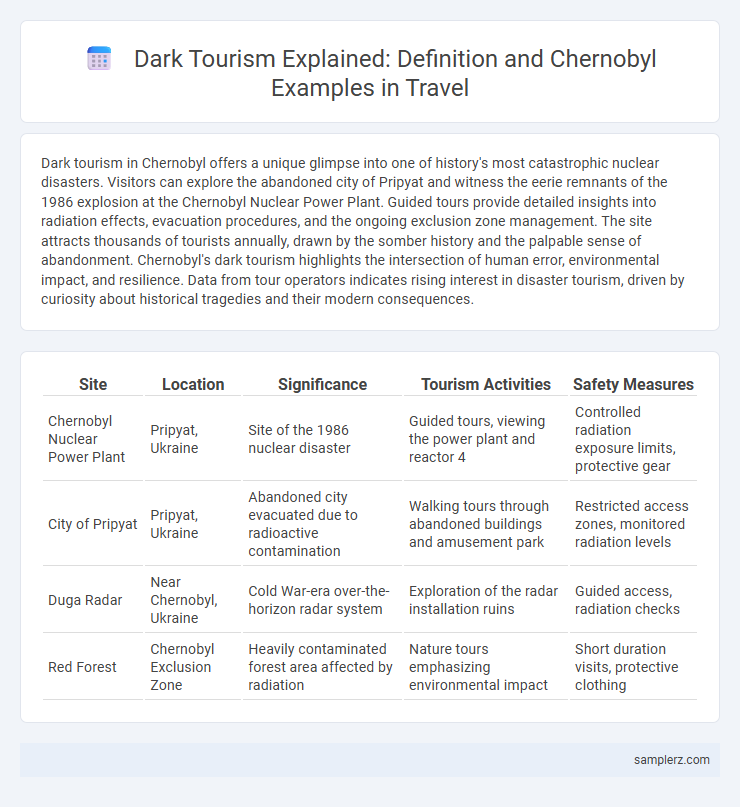Dark tourism in Chernobyl offers a unique glimpse into one of history's most catastrophic nuclear disasters. Visitors can explore the abandoned city of Pripyat and witness the eerie remnants of the 1986 explosion at the Chernobyl Nuclear Power Plant. Guided tours provide detailed insights into radiation effects, evacuation procedures, and the ongoing exclusion zone management. The site attracts thousands of tourists annually, drawn by the somber history and the palpable sense of abandonment. Chernobyl's dark tourism highlights the intersection of human error, environmental impact, and resilience. Data from tour operators indicates rising interest in disaster tourism, driven by curiosity about historical tragedies and their modern consequences.
Table of Comparison
| Site | Location | Significance | Tourism Activities | Safety Measures |
|---|---|---|---|---|
| Chernobyl Nuclear Power Plant | Pripyat, Ukraine | Site of the 1986 nuclear disaster | Guided tours, viewing the power plant and reactor 4 | Controlled radiation exposure limits, protective gear |
| City of Pripyat | Pripyat, Ukraine | Abandoned city evacuated due to radioactive contamination | Walking tours through abandoned buildings and amusement park | Restricted access zones, monitored radiation levels |
| Duga Radar | Near Chernobyl, Ukraine | Cold War-era over-the-horizon radar system | Exploration of the radar installation ruins | Guided access, radiation checks |
| Red Forest | Chernobyl Exclusion Zone | Heavily contaminated forest area affected by radiation | Nature tours emphasizing environmental impact | Short duration visits, protective clothing |
Introduction to Dark Tourism: The Allure of Chernobyl
Chernobyl stands as a prominent example of dark tourism, attracting thousands of visitors eager to explore the site of the 1986 nuclear disaster. The allure lies in its haunting landscapes, abandoned buildings, and the opportunity to witness history frozen in time. Tourists seek not only to understand the catastrophic impact but also to experience the eerie atmosphere and sobering lessons embedded in this tragic location.
Historical Overview: The Chernobyl Disaster
The Chernobyl disaster, occurring on April 26, 1986, remains one of the most catastrophic nuclear accidents in history, releasing massive amounts of radioactive materials into the environment. The explosion at Reactor 4 of the Chernobyl Nuclear Power Plant in Ukraine prompted the evacuation of over 100,000 people and created an exclusion zone covering approximately 2,600 square kilometers. Today, this tragic event draws dark tourism enthusiasts interested in exploring abandoned towns like Pripyat and understanding the profound impact of nuclear fallout on human history.
Chernobyl Exclusion Zone: A Surreal Travel Destination
The Chernobyl Exclusion Zone offers a unique dark tourism experience, attracting thousands of visitors annually to explore the haunting remnants of the 1986 nuclear disaster. This surreal travel destination features abandoned towns like Pripyat, where nature has reclaimed the area, creating eerie yet captivating landscapes. Guided tours provide insight into the historical catastrophe, radiation safety measures, and the ongoing efforts to contain the site.
Notable Landmarks: Pripyat Ghost Town and Abandoned Sites
Chernobyl's dark tourism highlights include the Pripyat Ghost Town, abandoned since the 1986 nuclear disaster, offering haunting views of deserted streets and decaying buildings frozen in time. Notable landmarks also feature the remnants of the Chernobyl Nuclear Power Plant and the Red Forest, showcasing the devastating environmental impact. These abandoned sites provide a powerful glimpse into the aftermath of one of the world's worst nuclear catastrophes.
Guided Tours: Exploring Chernobyl Safely
Guided tours in Chernobyl offer a safe and informative way to explore the site of the 1986 nuclear disaster, strictly adhering to radiation safety protocols. Expert guides provide detailed historical context while navigating restricted zones, including the abandoned city of Pripyat and the Chernobyl Nuclear Power Plant. These tours combine educational insight with safety measures, attracting travelers interested in dark tourism and post-apocalyptic landscapes.
The Impact of Radiation: Safety Protocols for Visitors
Radiation levels in Chernobyl's exclusion zone are carefully monitored to ensure visitor safety during dark tourism explorations. Strict safety protocols include limited exposure time, mandatory protective clothing, and guided tours to minimize risks associated with residual radioactive contamination. These measures help preserve visitor health while allowing a unique historical experience of the nuclear disaster site.
Emotional and Ethical Considerations in Chernobyl Tourism
Visitors to Chernobyl often experience a complex mix of fascination and somber reflection, confronting the devastating impact of the 1986 nuclear disaster. Ethical considerations arise as tourists navigate the fine line between education and exploitation, with many advocating for respectful behavior and awareness of local communities' trauma. Emotional responses range from awe at the site's eerie desolation to empathy for the victims, emphasizing the need for sensitive tourism practices that honor the region's history.
Chernobyl’s Influence on Popular Culture and Media
Chernobyl's influence on popular culture and media is profound, with numerous films, documentaries, and TV series such as HBO's "Chernobyl" dramatizing the 1986 nuclear disaster and its aftermath. This dark tourism site attracts thousands of visitors annually who seek to explore the abandoned city and contaminated Exclusion Zone, reflecting society's fascination with the catastrophic event. The portrayal of Chernobyl in media has significantly shaped public perception, highlighting themes of tragedy, human error, and environmental impact.
Visitor Experiences: Stories from the Chernobyl Zone
Visitors to the Chernobyl Zone report a mix of eerie silence and haunting beauty as they explore abandoned towns and the iconic reactor site. Many describe a profound emotional impact, reflecting on the 1986 disaster's human cost while witnessing nature's surprising resilience. Guided tours offer rare access to forbidden areas, combining historical education with a sobering atmosphere unique to dark tourism destinations.
The Future of Dark Tourism at Chernobyl
The future of dark tourism at Chernobyl involves expanding virtual reality experiences to provide immersive visits while preserving the site's integrity. Emerging technologies aim to enhance educational outreach by simulating radiation zones and historical events safely. Sustainable tourism practices are prioritized to balance public interest with environmental and cultural preservation.

example of dark tourism in Chernobyl Infographic
 samplerz.com
samplerz.com